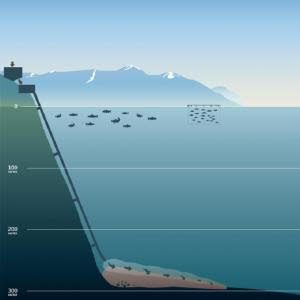
Deep Tailings Disposal in Norwegian Fjord. Illustration courtesy of Nordic Mining
The Issue: Terrestrial mining activity produces large volumes of waste, formed by the non-processed rock from overburden or access tunnels and shafts, and by the processed tailings. Tailings are the waste produced after extraction of the targeted metal from the ore through crushing and milling. This process produces particles that consist of one mineral and separates the minerals by their physical or surface characteristics. This fine-fraction slurry waste usually accounts for a high proportion of the waste disposed in a terrestrial mine.
Traditionally, tailings have been stored in land dams, but the lack of land availability, potential risk of dam failure, geological instability and topography in coastal areas in certain countries results in increasing preference for disposal of tailings into marine systems, a process usually known as Deep-Sea Tailings Disposal (DSTD). However, there are many critical issues that must be understood in relation to the existing receiving environment and the potential impacts of a proposed DSTD operation (including abiotic and biological processes). This results in the need for comprehensive, and often multi-phase studies as part of the assessment of a proposal for DSTD, particularly in poorly known deep-sea ecosystems.
The Working Group: The DSTD working group currently has 75 members and the group aims to provide an international platform to promote discussion and communication amongst stakeholders to deliver guidance on issues related to DSTD.
Current Activities:
- The Working Group is aiming to contribute to a global standard for DSTD, which will include guidance on both the studies required to assess a potential DSTD activity, the requirements for design and location of a DSTD operation, and the requirements for management and monitoring of DSTD operations during and after the mine life. DOSI, in conjunction with the Norwegian Minerals Industry (Norsk Bergindustri) will host a workshop to scope and kick start the global standard for DSTD, in Egersund, Norway in June 2021. Interested parties should contact the co-chairs in relation to attendance.
- The Working Group has links with the GESAMP (Joint Group of Experts on the Scientific Aspects of Marine Environmental Protection) Working Group on the impacts of wastes and other matter in the marine environment from mining operations, including deep-sea mining (WG 42, http://www.gesamp.org/newly-established-gesamp-working-group), led by Dr Tracy Shimmield
Past Activities (in reverse chronological order):
- A Scoping Paper designed as a tool to help all stakeholders to better understand deep-sea tailings disposal has been authored by members of this group: Vare LL, Baker MC, Howe JA, Levin LA, Neira C, Ramirez-Llodra EZ, Reichelt-Brushett A, Rowden AA, Shimmield TM, Simpson SL and Soto EH (2018. Scientific Considerations for the Assessment and Management of Mine Tailings Disposal in the Deep Sea. Front. Mar. Sci. 5:17. doi: 10.3389/fmars.2018.00017 )
- A Deep Sea Tailings Placement (DSTP) workshop (Lima, Peru – June 2015) was organised in collaboration with GESAMP and the International Maritime Organisation (IMO) and co-funded by IMO and the MITE-DEEP project (INDEEP & NFR, Norway). DOSI-DSTD funded the participation of 10 scientists who presented current data and knowledge on DSTD issues, from ecology, chemistry and physical oceanography to modelling. Meeting report with contributions from DOSI.
 DSTP Meeting Peru June 2015.
DSTP Meeting Peru June 2015.

